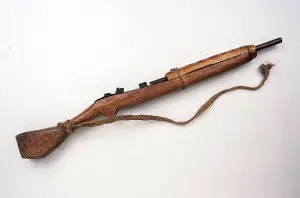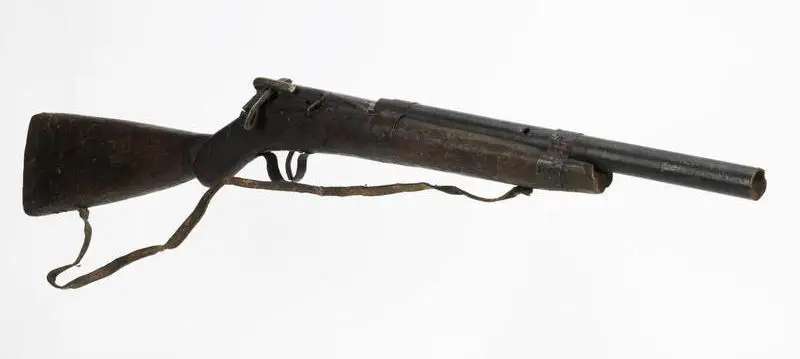“While expertise is high and growing in the art of weapons manufacture, the know-how in the production of cartridge [sic] and other ammunition is still lacking.” — Abdel-Fatau Musah, pull quote from the report in the Brown Journal of World Affairs, Spring 2002.
Abdel-Fatau Musah is an anti-gun activist sponsored by Holocaust collaborator George Soros’s Open Society Initiative for West Africa, and while much of what he wrote in a 2002 article in the Brown Journal of World Affairs, Small Arms: A Time Bomb Under West Africa’s Democratization Process, was tendentious nonsense, he made some comments on improvised weapons that illustrate a point we keep hammering on: you can’t really ban guns, because you can’t uninvent the technology. From the thatched secret armories of Mindanao to the Tribal Trust Lands of Pakistan, humans who believe they need to arm themselves find entrepreneurs that arm them.

Improvised firearms are not new; they were once a reaction to colonialists’ disarmament schemes. This smoothbore was built and used by Mau-Mau terrorists in the 1950s.
These third world armories have yet to produce a John M Browning, but it just might happen. As Musah notes, after deploring the existence of massive war stockpiles and ill-protected government armories, and blaming the great powers for the fact that the end of colonialism could be mistaken for the end of civilization in much of Africa, if there’s no handy stockpile a gunsmith will invent himself and start building one.
And the more he does it, the better he gets.
If one looked up the Small Arms Survey of 2001 for the list of arms producers, one would find that only Nigeria and Guinea possess the capacity to produce limited quantities of light weapons and ammunition in West Africa. Throughout the sub-region, however, cottage industries with the capacity to produce sophisticated firearms and imitation assault rifles dot the countryside. Originally established to meet local demands for hunting, these secret factories have grown in expertise and capacity to satisfy ever-growing demands brought about by general insecurity.
He also notes that the unauthorized gunsmiths react rationally to government pressure.
To avoid detection and repression, producers in Ghana have established networks of parts manufacturers, with each cell specializing in the production of specific components of the rifle. The components so produced separately—barrels, triggers, butts—are later assembled at a secret location for distribution. While expertise is high and growing in the art of weapons manufacture, the know-how in the production of cartridge [sic] and other ammunition is still lacking. The high rate of inward smuggling of ammunition is a consequence of this fact; this dependence offers options to control the overall trade.
He writes the conclusion to that paragraph as if he didn’t understand what he just said in the preceding lines.
If you try to restrict ammunition, yes, they’ll just make that, too. It’s not rocket surgery.

Here’s another Mau-Mau blaster from the IWM. We struck out on images of the recent Ghanaian weaponry. Even the Impro Guns blog doesn’t have any.
Ghana, for instance, banned the local manufacture of firearms in 1962. Ten years later, they amended the Arms and Ammunition Act to allow manufacture with a license — and no license has ever been granted, or, for that matter, applied for. Yet guns are widely made.
Ghana, under the ECOWAS treaty and with the help of the EU and the Friedrich-Ebert-Stiftung, a German foundation named after a Weimar era politician. The foundation’s politics are best understood by its veneration of the Karl Marx Haus in Trier, Germany, where it maintains a library of the “scientific socialism” it supports, and a hagiographic museum of the man who inspired the world’s greatest mass murders. It even says the baroque setting of Marx’s birthplace will “take you captive with its charms.” Well, if there’s one thing Marx’s ideology produced, it’s plenty of prisoners!
The Polish officers of 1939 were not available for comment, neither were the Old Bolsheviks of 1936-38, the 18 million who went into the Gulag, the millions that never came out, etc., etc.,
In Germany, the FES seems to overlap politically with the Rosa Luxemburg Foundation, which is descended from the East German quisling government and which has an anti-semitic tilt (ironic, as Luxemburg was Jewish. But many of the founding “Communists” of East Germany were resprayed Nazis, and by 1945 the original Communists, many of them Jewish, had been exterminated under red star as well as swastika, so maybe not so ironic).
ECOWAS, the EU and the FES consider minimum small arms regulations to be national and international registration, extremely restrictive may-issue permitting, and confiscations “as needed”.
His ultimate conclusion is even further afield — that SALW (the international ban seekers’ term for “Small Arms and Light Weapons”) — need to be controlled internationally, like nuclear weapons.
At least two problems with that conclusion arise:
- the nuclear nonproliferation regime is extremely costly, which has only been justified by a strong international consensus for it at most times; and,
- the nuclear nonproliferation regime has failed repeatedly, and is failing again with respect to Iran.
No one is likely to sanction homegrown revolver development like they do, say, homegrown enriched-uranium manufacture. And as he noted with respect to the Ghanian bush gunsmiths, bans have consequences, but never the intended ones.
This is just one more attempt by Africans and their enablers in international organizations to try to shift the blame for misconduct by African individuals and governments onto other powers.

Kevin was a former Special Forces weapons man (MOS 18B, before the 18 series, 11B with Skill Qualification Indicator of S). His focus was on weapons: their history, effects and employment. He started WeaponsMan.com in 2011 and operated it until he passed away in 2017. His work is being preserved here at the request of his family.


11 thoughts on “Improvised Weapons in Africa”
Hmmm, iI dont know how they are going to make new cartridges. That is some large expensive industrial scale equipment for the drawing. This would probably be quite easy to spot unless they could hide a small low production press, but even then in these countries aren’t the components for modern powder heavily regulated? They could maybe reuse, mill. or make plastic low power rounds.
The “pre” nation of Israel Israelis concealed an ammunition factory in the basement of a building.
http://www.thedailybeast.com/articles/2014/07/18/israel-had-a-secret-underground-bullet-factory.html
Whether the Brits never actually figured it out, or conveniently never really made a concerted effort to find the factory may never be known.
The truth of guerilla resupply: rounds get you more rounds.
There are other means of feeding repeating rock chuckers than brass and chemistry. Compressible fluids, for instance. Maybe I’m just blowing hot air, but Lewis & Clark made a hit with their gizmo.
I was visiting a friend recently and he had a compressed-air mortar on hand. French in origin, WWI. Fires very comical looking 50mm micro mortar rounds. The IRA launched propane canisters full of HE from larger propane canisters repurposed as mortars, too.
Mortars are the dirty little secret of infantry combat. They’re a big killer.
Why is that? Higher rate of fire, lower cost than that of other artillery?
Simplicity and portability. Apart from improvements in propulsion and explosives chemistry, and in precision of manufacture (yielding greater accuracy), the thing is barely improved from the Stokes design of a century ago. Today’s infantry mortars are deadlier than WWI’s artillery pieces, and yet, an infantry platoon can take one or two along (as a slice from the mortar or weapons platoon in most armies). And then you can dominate terrain out to maybe 8,000 meters (depending on your mortar and observation).
Ben Gurion and his revolutionaries scratchbuilt a complete cartridge production line, including manufacuture of powder and primers, and successfully kept it hidden from the British.
As for the Ghanese… the Kalashnikov rifle was clearly engineered for small-shop manufacture. The Motherland needed small arms, but there were more important demands on industry than new rifles. There are few critical dimensions on an AK, and other than rifling the barrel, most parts can be made on small equipment, or even by hand, as demonstrated by the classic armsmakers of Darra Adam Khel.
The AK could be simpler; the Valmet got rid of the complicated quick-release handguard and rear sight mechanisms, among other things.
Rifling can be done (and for centuries was) by hand-operated, mostly-wooden machinery, too.
A lot of people are mentioning Israeli hiding of that munitions factory. I may note that they used preformed brass cases from lipstick containers to get past the materials regulations and after that they used small presses hidden under a large noisy laundromat. Governments and arms control have gotten better in the last couple decades and raw materials can be more carefully scrutinized, I am not saying it couldn’t be done but mass production is not happening.
The IRA, despite the embargo by the Brits, using tiny basement workshops, turned out automatic weapons of the same quality – or better – than what the US was turning out during WWII. Including ammunition.
Any 2nd year chemistry student can obtain the precursor chemicals needed to create useable gunpowder and primer compounds. The chemistry is very old, dating back to the US Civil War. Old fashioned mercuric primers can be made – and even spent primers can be re-watted if you know the methodology and chemistry. During WWII, here in the US, so much ammo was being diverted to the war effort that two very smart men sat down and, probably with the help of a professional chemist, figured out not only the chemistry, but the safety protocols for making pistol and rifle ammo on a small scale using easily obtainable chemicals.
Primers for Small Arms Cartridges by M.J. Albert and H.F. Oelberg
Hard to find, but worth inclusion into your library. Also lists several recipes for smokeless and semi-smokeless powder.
As far as useable brass, any Mechanical Engineer worth his salt could sit down and design a small hand-op hydraulic press that can use brass sheet to fab cases incrementally. Yes, it will be slow, but it will be small, portable and very quiet. Some is better than none. And any sympathetic tool and die maker can – using the blueprints from the M.E. – spin up what’s needed…
It need not be cutting edge. Or even electrically powered. It just has to work.